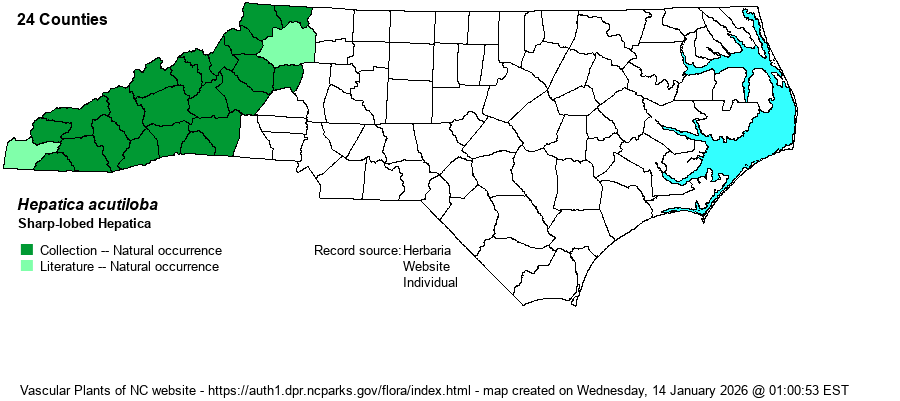| Author | de Candolle | |
| Distribution | Throughout the Mountains, and ranging into the higher western Piedmont.
This is a Northern species, from southern Canada south mainly along the Appalachians to AL, MS, and AR. Note that the BONAP map lumps this species into H. americana, and thus is incorrect for this taxon. | |
| Abundance | Common in the Mountains; rare to uncommon in the higher elevations of the western Piedmont. Note that because NatureServe does not consider this taxon a full species, but as just a variety, it ranks the taxon as G5T5; this means that this website, which follows Weakley (2018), must give the taxon a species rank of G5Q. | |
| Habitat | This is a characteristic species of Rich Cove Forests, as well as other forests over circumneutral soils. It can also be found in Northern Hardwood Forests and several other forests with rich soils. |
| Phenology | Blooms mostly in March and April, and fruits shortly after flowering. | |
| Identification | This is one of the few "evergreen" species of Ranunculaceae. It is a low-growing herbaceous species, only reaching about 6 inches tall. The several basal leaves are 3-lobed (connected at the base), each lobe being rhombic, with rather straight sides reaching a rather acute tip; each leaf is about 2 inches wide and long. These leaves remain through the winter, but new leaves and the flowering stalks emerge in late winter. The bare flowering stalk grows several inches tall and bears a single flower, though there are typically several such flowering stems per plant. The flower consists of 5-12, usually 5-6, sepals, colored lavender-blue to whitish, and about 1 inch wide. In this species, the bracts are acute and often show between the sepals when seen from above. The very similar H. americana, often considered as the same species, has the three lobes of the leaf broadly rounded, and the bracts beneath the sepals are also rounded and usually are not visible when viewing the flower from above. In general, H. acutiloba flowers average a bit paler in color, often more whitish, than are those of H. americana, and there are often somewhat more sepals (more than 6), whereas H. americana seldom has more than 6 sepals. Each of these species is a "harbinger of spring", often being one of the first few spring wildflowers an observer notices in late winter -- along with Dimpled Trout-lily (Erythronium umbilicatum), spring-beauty (Claytonia spp.), and a few others. | |
| Taxonomic Comments | Some references, including NatureServe, BONAP, and others, lump these two species into one species -- some as H. americana var. acutiloba and some others as H. nobilis var. acuta. A few also include these two in the genus Anemone, with the name of Anemone acuta for this species and Anemone americana for the other. Weakley (2018) uses the traditional names of most references from the middle of the 20th Century, and he gives compelling reasons for doing this.
| |
| Other Common Name(s) | Sharp-lobed Liverleaf | |
| State Rank | S4 | |
| Global Rank | G5T5 [G5] | |
| State Status | | |
| US Status | | |
| USACE-agcp | | |
| USACE-emp | | |

